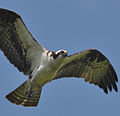| Type | Symbol | Description | Adopted | Image | Note |
|---|
| Animal | American beaver
(Castor canadensis) | Found in most of the larger streams and rivers in Oregon, the beaver is the largest of the North American rodents. Once overtrapped by early settlers and prized for its fur, populations have recovered through management and partial protection. Oregon is known as "The Beaver State" and Oregon State University's athletic teams are called the Beavers. [10] [11] | 1969 |  | [12] |
| Crustacean | Dungeness crab
(Metacarcinus magister) | Based on lobbying from school children at Sunset Primary School in West Linn, Oregon, and citing its importance to the Oregon economy, the Oregon State Legislature designated the Dungeness crab as the state crustacean in 2009. | 2009 |  | [13] |
| Fish | Chinook salmon
(Oncorhynchus tshawytscha) | Salmon was essential for the coastal Native Americans' life, and was the subject of many legends and taboos. The largest of the Pacific salmon, the Chinook provides both sport and commercial fishing, but is under threat from dams and fishing. | 1961 |  | [14] |
| Flower | Oregon-grape
(Mahonia aquifolium) | Native to the North American west coast, the Oregon-grape is an evergreen shrub that contains small purplish-black fruits that were included in smaller quantities in the traditional diets of Pacific Northwest aboriginal peoples. Today they are sometimes used to make jelly, alone or mixed with salal berries, another berry native to the Northwest. [15] | 1899 |  | [16] |
| Fruit | Pear
(Pyrus) | Pear orchards flourish in Oregon's river valley growing regions, producing about 800 million pears per year. Pears are Oregon's number one tree fruit crop. | 2005 |  | [17] |
| Insect | Oregon swallowtail
(Papilio oregonius) | Containing the word Oregon in both its common and scientific names, this swallowtail species is native to the Northwest region, primarily found in the sagebrush canyons of the Columbia River and its tributaries. | 1979 |  | [18] |
| Microbe | Brewer's yeast
( Saccharomyces cerevisiae ) | S. cerevisiae has been instrumental to winemaking, baking and brewing since ancient times as the yeast behind the most common type of fermentation. It is a unicellular fungus about 5–10 micrometres in diameter. In addition to its role in food production, the yeast is used as a model organism for the study of aging, genomics, and other topics. | 2013 |  | [2]
[19] |
| Mushroom | Pacific golden chanterelle
( Cantharellus formosus ) | Most known for its "golden hue, chalice shape and delicate woodsy flavor", the Pacific golden chanterelle is a fungus found throughout Oregon's conifer forests. Tillamook State Forest annually produces one of the world's largest chanterelle harvests. | 1999 |  | [20] |
| Nut | Hazelnut | Hazelnuts, also known as filberts, are produced in commercial quantities in Oregon, which has an ideal climate for growing the nuts. According to the state, Oregon's Willamette Valley is home to 99% of the U.S. hazelnut industry. | 1989 |  | [21] |
| Raptor | Osprey
(Pandion haliaetus) | "Designated state raptor by the 2017 Legislature, declaring the large bird with its striking markings to be a fitting symbol of Oregon's rugged independence, strength and resilience, evoking Oregon’s lakes, rivers, streams and ocean". | 2017 |  | [22] |
| Seashell | Oregon hairy triton
(Fusitriton oregonensis) | Named oregonensis by conchologist John Howard Redfield in 1846 to honor the Oregon Territory, the Oregon hairy triton is covered with bristly periostracum and found along the West Coast, washing up at high tide. [23] | 1991 |  | [1]
[9] |
| Songbird | Western meadowlark
(Sturnella neglecta) | Unofficially chosen as the state bird in 1927 by Oregon's school children in a poll sponsored by the Oregon Audubon Society, the western meadowlark is native throughout western North America and is known for its "distinctive and beautiful song." [24] However, the Governor's proclamation based on the poll was never ratified by the Oregon Legislature. In order to correct this oversight, the western meadowlark was voted State Songbird in 2017. [25] | 2017 |  | [26] |
| Tree | Douglas-fir
(Pseudotsuga menziesii) | Named after David Douglas, a Scottish botanist who traveled through Oregon in the 1820s, the Douglas-fir is an evergreen conifer dominant throughout the region, occurring in nearly all forest types and able to compete well on most parent materials and slopes. Due to its "strength, stiffness and moderate weight", the species is an invaluable timber product. | 1939 |  | [9] |
| Vegetable | Potato | Potatoes are the number one vegetable produced in Oregon, with over 2.7 billion pounds grown annually. | 2024 |  | [27] |






























